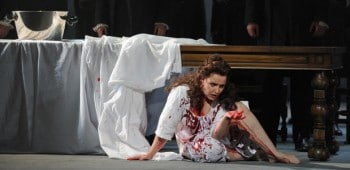Opera Australia: Emma Matthews’ marvellous madness
The enduring popularity of Donizetti’s Lucia di Lammermoor can perhaps be compared to childbirth: the beautiful music and emotional power of Act III ameliorates the memory of the often painful banality of the preceding acts. I have seen prod
uctions of Lucia that have managed to cope with its innate flaws but this version, with its overstated unrelenting grey and expressionless world, only becomes alive during the famous mad scene.

Composed in 1835, Lucia was rarely performed till after World War II when sopranos of the calibre of Maria Callas and Joan Sutherland became renowned champions of the fiendishly difficult coloratura role. The success of the opera hangs entirely on the soprano, and this production is served particularly well by Opera Australia star Emma Matthews. With sweet, pitch-perfect singing and mature acting her mad scene was intensely moving and elicited an appropriately rapturous response from the audience.
Matching her in brilliance is tenor Aldo Di Toro as Lucia’s lover Edgardo. His unaffected acting and attractive bel canto singing bring considerable depth to the role – what a pity he has to come onstage and sing two arias after Lucia’s climactic scene. This would have to be the most thankless task for any tenor!
The remainder of the cast, too, is uniformly excellent. Giorgio Caodura as Lucia’s brother Enrico, is properly menacing and his Italianate, resonant baritone, manages (where others struggle in vain) to rise above the often dense orchestration and the deadening acoustic. As an impossibly handsome, glowering Arturo, tenor Stephen Smith continues to impress and Teresa La Rocca is solid as Alisa. As Riamondo, bass David Parkin is impressive in his singing, but is still growing into the dramatic authority required for this pivotal role.
This production by director John Doyle has been staged previously in Houston, Naples and Sydney. A stark cloudy grey stage is animated only by descending screens of more clouds that soon wear out their dramatic import. I was seated to the side of the theatre, so missed out on the best effect of the angular drops of the set and the repetitive walking forwards and back choreography of the chorus. From where I was, the movement seemed gratuitous, and the unimaginative, old-fashioned blocking of the principals, particularly in duets and ensembles substantially contributed to the clunky feeling of the first two acts. Even the musical highlight of the sextet in Act II was an anti-climax, due to the placement of the singers across the wide State Theatre stage.
That said, what will be remembered from this production is Emma Matthew’s triumphant Lucia, from her radiant Regnava nel silenzio in Act I to her ethereal singing and poignant acting in the mad scene. This performance assures Matthew’s status as one of this generation’s finest singers.

